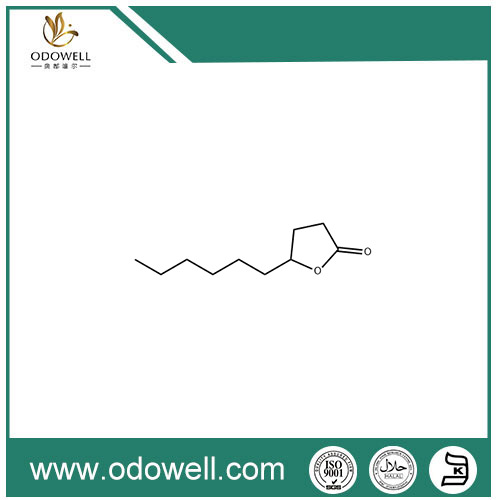

(S)-(-)-γ- Nonalactone natural has a wide range of applications, including:
- Fragrance industry: (S)-(-)-γ- Nonalactone natural is widely used in perfumes, colognes, body lotions, and other personal care products to give a sweet, milky, and musky aroma. It is often used in combination with other fragrance ingredients, such as isoamyl acetate, vanillin, and coumarin, to create unique and memorable scents.
- Food industry: (S)-(-)-γ- Nonalactone natural is a natural flavoring agent that is used to enhance the flavor and aroma of various food products, including baked goods, dairy products, desserts, and beverages. It is generally recognized as safe (GRAS) by the US Food and Drug Administration (FDA) and the European Food Safety Authority (EFSA).
- Pharmaceutical industry: (S)-(-)-γ- Nonalactone natural is used in some drugs and medicinal products due to its pleasant aroma and taste. It may also have some therapeutic effects, such as antifungal and antibacterial properties.
According to the available research, (S)-(-)-γ- Nonalactone natural is generally safe for use in the intended applications. However, some people may be allergic or sensitive to this compound and may experience adverse effects, such as skin irritation, rash, or respiratory symptoms, when exposed to it. In rare cases, (S)-(-)-γ- Nonalactone natural may cause headaches, dizziness, or nausea.
(S)-(-)-γ- Nonalactone natural is available from many suppliers and distributors of fragrance and flavor ingredients. Some of the popular sources include Sigma-Aldrich, Penta Manufacturing Company, and Fuzhou Farwell Import & Export Co., Ltd. It is important to choose a reputable supplier that provides high-quality and pure (S)-(-)-γ- Nonalactone natural to ensure the safety and efficacy of your products.
There are many other natural compounds that have similar fragrance profiles to (S)-(-)-γ- Nonalactone natural, including:
- γ-Decalactone
- δ-Decalactone
- γ-Valerolactone
- γ-Nonanolide
- γ-Dodecalactone
In conclusion, (S)-(-)-γ- Nonalactone natural is a valuable and versatile natural flavor and fragrance compound that has many applications in various industries. It provides a sweet, creamy, and musky scent that is widely appreciated by consumers. However, it is important to use (S)-(-)-γ- Nonalactone natural in moderation and to ensure its purity and quality to avoid any adverse effects. If you have any further questions or concerns about (S)-(-)-γ- Nonalactone natural, please consult your supplier or a qualified professional.
KUNSHAN ODOWELL CO., LTD is a leading supplier of high-quality fragrance and flavor ingredients, including (S)-(-)-γ- Nonalactone natural. We provide a wide range of products and services to meet the diverse needs of our customers worldwide. Our mission is to help our clients create unique and memorable products that enhance the quality of life. Please visit our website at https://www.odowell.com to learn more about us and our products. For any inquiries or orders, please contact us at shirleyxu@odowell.com.
1. Acree, T. E. (2018). γ-Nonalactone natural. In T. E. Acree & H. Teranishi (Eds.), Flavor Chemistry: Thirty Years of Progress (pp. 49-60). Springer.
2. Beaulieu, J. C., & Grimm, C. C. (2001). Identification of volatile compounds in cantaloupe at various developmental stages using solid phase microextraction. Journal of Agricultural and Food Chemistry, 49(3), 1345-1352.
3. Chen, J., & Liu, Y. (2014). Optimization of headspace solid-phase microextraction for the determination of lactones in milk by gas chromatography-mass spectrometry. Journal of Chromatography A, 1346, 107-113.
4. Heyerick, A., Dejaegher, B., & Van Durme, J. (2012). Comprehensive 2D gas chromatography of lactones in rum using a combination of ionic liquid and polar columns. Journal of Separation Science, 35(7), 833-839.
5. Li, R. W., Li, C., & Elmore, J. M. (2014). γ-Decalactone, a volatile compound produced by Geotrichum candidum, reduces the postharvest blue mold decay of apples. Journal of Agricultural and Food Chemistry, 62(13), 2915-2922.
6. Lu, X. M., Chen, J. X., & Yang, D. J. (2010). Comparison of different extraction methods for determining lactones in milk. Journal of Chromatography B, 878(28), 2763-2770.
7. Ravid, U., Putievsky, E., Katzir, I., & Lewinsohn, E. (1992). Enantiomeric composition of lactones from peach (Prunus persica) and apricot (Prunus armeniaca) fruits. Journal of Agricultural and Food Chemistry, 40(11), 2152-2155.
8. Song, H., Peng, H., & Chen, F. (2009). Headspace solid-phase microextraction gas chromatography-mass spectrometry for determination of lactones in milk. Journal of Dairy Science, 92(9), 4294-4302.
9. Takeoka, G. R., Buttery, R. G., & Naim, M. (1989). Flavor chemistry of peach and apricot. In R. Teranishi, R. G. Buttery, & H. Sugisawa (Eds.), Bioactive volatile compounds from plants (pp. 212-231). ACS Symposium Series 406. American Chemical Society.
10. Volpe, F., & Marangon, M. (2005). Lactones in food: A review of their sensory attributes and analysis. Italian Journal of Food Science, 17(1), 2-16.